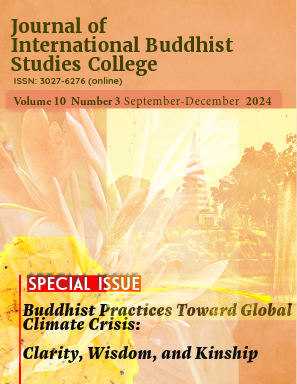The Practical Ways of Righteous Individual’s Donation According to Sappurisa-dāna Sutta
Main Article Content
Abstract
This article investigates the practical approaches to righteous giving as outlined in the Sappurisa-dāna Sutta, a key teaching in Theravāda Buddhism. The study addresses three objectives: (1) to examine the general concept and significance of donation (dāna) from a Theravāda Buddhist perspective, (2) to analyze the characteristics and principles of righteous giving as prescribed in the Sappurisa-dāna Sutta, and (3) to explore the practical application of these principles in contemporary daily life. Utilizing a documentary research methodology, this study synthesizes insights from canonical Pāli scriptures and relevant secondary sources.
The findings reveal that the concept of dāna in Theravāda Buddhism extends beyond material generosity to encompass the cultivation of wholesome mental states, ethical conduct, and the intention behind the act of giving. The Sappurisa-dāna Sutta highlights several attributes of a righteous donor, including discernment of the recipient’s virtues, understanding the value of the gift, awareness of the appropriate timing, and the donor’s state of mind during the act of giving. These attributes emphasize not only the act of generosity but also the wisdom and ethical consideration underpinning it.
The study further explores how these principles can be integrated into contemporary life. For instance, by aligning giving practices with mindfulness, ethical awareness, and social responsibility, individuals can contribute meaningfully to their communities while fostering inner peace and spiritual growth. The study also identifies potential challenges in practicing righteous giving, such as misconceptions about altruism and societal influences on charitable behavior. It provides practical recommendations to overcome these obstacles, ensuring that the essence of dāna aligns with its intended spiritual and ethical goals.
This investigation highlights the transformative potential of dāna as an instrumental approach to nurturing compassion, mitigating egocentric inclinations, and fostering a cohesive society grounded in the doctrines of Theravāda Buddhism. By adhering to the precepts delineated in the Sappurisa-dāna Sutta, individuals are allowed to engage in acts of generosity that yield advantages for both themselves and the collective, thereby achieving an equilibrium between personal development and societal welfare. This synthesis of Buddhist philosophical insights with contemporary methodologies illustrates the persistent significance of Buddhist tenets in promoting a compassionate and ethically principled world.
Article Details
The Journal of TCI is licensed under a Creative Commons Attribution-NonCommercial-NoDerivatives 4.0 International (CC BY-NC-ND 4.0) licence unless otherwise stated. Please read our Policies page for more information on Open Access, copyright and permissions.
References
Adomavičiūtė, K. & Urbonavičius, S. (2023). Does the intention to purchase cause‐related products compared to charity donations indicate higher morality?. Journal of Philanthropy and Marketing, 28(4). https://doi.org/10.1002/nvsm.1811
Bhikkhu Bodhi, (2002). The Practice of Giving: Essays on Generosity in the Buddhist Tradition. Buddhist Publication Society.
Bhikkhu Bodhi. (1978). The All-Embracing Net of Views: The Brahmajala Sutta and Its Commentaries. BPS Pariyatti Editions.
Bhikkhu Bodhi. (1990). The Noble Eightfold Path: Way to the end of suffering. Buddhist Publication Society.
Bhikkhu Bodhi. (2017). The principles of righteous giving in Theravāda Buddhism.
Bhikkhu Bodhi. (Ed.). (2011). Dāna: The Practice of Giving-Selected Essays. The Wheel Publication No. 367/368/369.
Bhikkhu Sujato. (2018). Numbered Discourses: A sensible translation of the Aṅguttara Nikāya. Sutta Central.
Bhikkhu Sujato. (2018). The Vacchagotta Sutta.
Boninsegni, M. F., Roy, A., Bakpayev, M., Kumar, S., Peronard, J., & Reimer, T. (2021). Opportunities of and threats to consumer well-being in the age of fourth industrial revolution (ir 4.0) technologies. Digital Policy, Regulation and Governance, 24(1), 93-105. https://doi.org/10.1108/dprg-06-2021-0080
Caviola, L., Schubert, S., & Greene, J. D. (2021). The psychology of (in) effective altruism. Trends in Cognitive Sciences, 25(7), 596-607.
Deeter‐Schmelz, D. R. (2015). Proceedings of the 2010 Academy of Marketing Science (AMS) Annual Conference. https://doi.org/10.1007/978-3-319-11797-3
Dellaportas, S. (2006). Making a difference with a discrete course on accounting ethics. Journal of Business Ethics, 65(4), 391-404. https://doi.org/10.1007/s10551-006-0020-7
Dwidienawati, D., & Abdinagoro, B. (2018). Generosity’s antecedents and outcomes -A proposed relationship between Generosity and Intention in Indonesia’s BPJS Kesehatan. Journal of Business and Retail Management Research (JBRMR), 12(2), 49-59.
Endo, T. (1986). Buddhism in Focus: An In-depth Study of Dāna Practices. University of Delhi Press.
Findly, E. B. (2003). Dāna: Giving and Generosity in Indian Religions. Motilal Banarsidass Publishers.
Hardy, E. (1958). The teachings of the Sappurisa-dāna Sutta: A framework for ethical giving.
Hardy, E. (1976). Aṅguttara Nikāya: The book of the gradual sayings. Pali Text Society.
Harvey, P. (2000). An Introduction to Buddhist Ethics: Foundations, Values, and Issues. Cambridge University Press.
Janakabhivamsa, A. S. (1999). The Noble Practice of Giving in Buddhism. Yangon University Press.
Keown, D. (2020). Buddhist ethics: A very short introduction. Oxford University Press.
Kuhn, B. (2024, Feb 10). How many causes should you give to? https://www.benkuhn.net/ how-many-causes/
Manli Sayadaw Maghadeva Linkathit. (1976). Practical Challenges in Philanthropy.
Mingun Tipitakadhara Sayadaw Vicittasābhivamsa. (1345). The five principles of donation: A guide for practitioners.
Nonnis, M., Massidda, D., Cabiddu, C., Cuccu, S., Pedditzi, M. L., & Cortese, C. G. (2020). Motivation to donate, job crafting, and organizational citizenship behavior in blood collection volunteers in non-profit organizations. International Journal of Environmental Research and Public Health, 17(3), 934. https://doi.org/10.3390/ ijerph17030934
Rhys Davids, T. W. (1899). Buddhist Sutta: Sacred books of the East, Volume 11. Oxford: Clarendon Press.
Saeri, A. K., Slattery, P., Lee, J., Houlden, T., Farr, N., Gelber, R. L., Stone, J., Huuskes, L., Timmons, S., Windle, K., Spajic, L., Freeman, L., Moss, D., Behar, J., Schubert, S., Grundy, E. A. C., & Zorker, M. (2023). What works to increase charitable donations? A meta-review with meta-meta-analysis. VOLUNTAS: International Journal of Voluntary and Nonprofit Organizations, 34(3), 626-642. https://doi.org/10.1007/ s11266-022-00499-y
Silk, J. B., & House, B. R. (2016). The evolution of altruistic social preferences in human groups. Philosophical Transactions of the Royal Society. B: Biological Sciences, 371(1687), 20150097. https://doi.org/10.1098/rstb.2015.0097
Smith, C., & Davidson, H. (2014). The paradox of generosity: Giving we receive, grasping we lose. Oxford University Press.
Tsong-Kha-pa. (2002). Dāna and the cultivation of spiritual wealth.
Ubeysekara, A. (2023, January 4). Dakkhinā Vibhanga Sutta: Discourse on analysis of offerings. https://drarisworld.wordpress.com/2023/01/04/dakkhina-vibhanga-sutta-discourse-on-analysis-of-offerings/


